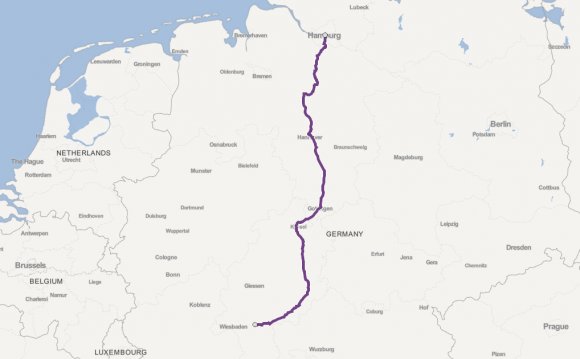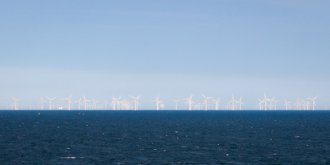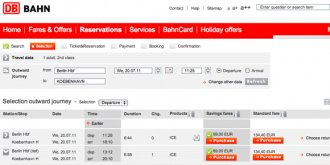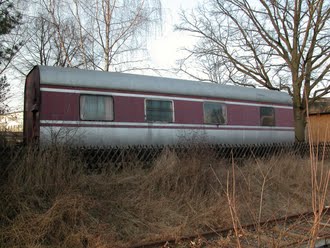
 Taking the train from Hamburg to Copenhagen – did you know the train goes in a ferry (not over bridge) to cross the Baltic Sea?
Taking the train from Hamburg to Copenhagen – did you know the train goes in a ferry (not over bridge) to cross the Baltic Sea?
A few days ago my travel companion and I spontaneously decided at 9:30am to catch the 1:12pm train for a 3 day trip to Copenhangen from Berlin via Hamburg. I knew getting to Copenhagen from Germany required crossing the Baltic Sea, but I assumed the train would travel go over a bridge.
To my surprise, the train actually goes into a ferry at the port in Germany, and then exits the ferry once it arrives in Denmark.
Here’s how it works:
– Train enters the bottom deck of the ferry (there are tracks), along with other vehicles
– Passengers exit the train and go 2 floors up to the ferry decks for the 45 minute journey
– When the ferry nears the port, passengers board the train again
– Train exits the holding area of the ferry and continues onward in Denmark
 Cool sights during the ferry crossing
Cool sights during the ferry crossing
The ferry was relatively large, carrying the train plus multiple lanes of trucks and vehicles. It also had a range of shops and even multiple decks on board.
- Ferry amenities – multiple restaurants/cafeterias, “duty free” shops, in-door areas with views of the sea, plus large outdoor decks
- Beautiful scenery – groups of seagulls soaring alongside the ferry, view of the sparkling dark blue Baltic Sea and other ferries/boats
- Off-shore wind farms in the distance – this was the most interesting sight for me. I’ve seen a handful of wind turbines on land, so seeing massive wind farms on the water was completely new to me. Apparently 19% of electricity in Denmark is generated by wind power .
Berlin to Copenhagen in 1st Class
The novelty of crossing the Baltic Sea by boat was the highlight of this journey (45 min out of a 7 hour trip), but the train rides were enjoyable as well. The German “ICE” (Intercity Express) trains were very sleek on the outside and comfortable on the inside.
We used a travel day of our Eurail Global Pass and sat in first class.
What we got with our 1st class seats:
- Hamburg to Copenhagen: Free snack (extra large Twix, Snickers, M&Ms, croissant)
- Hamburg to Copenhagen: Free and unlimited tea, coffee and/or sparkling water
- FIFA World Cup chocolates
- As usual, extra space – 3 chairs per row in first class vs. 4 chairs per row in 2nd class
- Tables in 1st class are actual tables in front of the seat, was great for using our MacBooks. In 2nd class it’s mostly tables that fold down, like on airplanes.

Duration and train schedule
- Total duration – Berlin to Copenhagen was 7 hours
– Berlin to Hamburg: 1 hour 40 min
– Connection: 35 min
– Hamburg to Copenhagen: 4 hours 45 min - Multiple trains daily – between Berlin and Copenhagen trains leave 6-7 times a day. Most routes require a connection in Hamburg. There is also one direct train per day from Berlin to Copenhagen that leaves at 11:26 and arrives at 18:31.
We took the 1:12pm train and arrived just after 8pm. 8pm sounds late, but in the summer the sun doesn’t set until around 10pm in Copenhagen so it was still bright when we arrived.
Tips for the train/ferry crossing:
- Getting ready for the crossing – The train station before you board the ferry is “Puttgarden” (Germany), and the train stop on the Danish side is “Roedby”. When you approach the station, the conductor will announce in German/Danish/English that you’ll need to exit the train.
- Leaving belongings on the train – the train will be locked by the conductor once everyone exits. I left my large backpack in the train but took my valuables with me.
- Take a sweater – the outdoor deck of the ferry was quite windy.
- Re-boarding the train – When the ferry nears the destination, you’ll hear an announcement to return to the train. Don’t wait until last minute to go back. I stayed a bit longer to take photos on the deck and then rushed back to the train.
 The train started about 30 seconds after I entered and I didn’t see the conductor do a head-count. I’m pretty sure the train would have left without me ;)
The train started about 30 seconds after I entered and I didn’t see the conductor do a head-count. I’m pretty sure the train would have left without me ;) - Boarding the wrong train – I believe there was only one track on the ferry, so no worries about boarding the wrong train and ending up in a different destination :)
Train prices with and without Eurail Global Pass
This route was definitely worth using a travel day of our Eurail Global Pass.
The standard fare just for 2nd class was 134.40 euros ($182), whereas our rail pass covers 1st class seats by default (212.80 euro standard price, $288).
Below is a comparison of ticket costs for 1st class, 2nd class, special fare (booked in advance), and standard fare, if we bought individual tickets instead of using our Eurail pass. Prices are one-way only and from Germany’s rail company website, bahh.de.
At the time of writing, 1 EURO = $1.36 CAD = $1.40 USD = $1.32 AUD
| Berlin to Copenhagen | Cost without Eurail pass | Cost w/Eurail pass |
| 1st class seat | 212.80 euro, standard ($288)
99 euro & up, in-advance ($134) |
|
| 2nd class seat | 134.40 euro, standard ($177)
69 euro & up, in-advance ($91) |
|
| Seat reservation | Not required |
If you’re stopping in Hamburg for a day(s) before Copenhagen, below are the prices for individual segments. Prices are one-way.
| Berlin to Hamburg | |
| 113 euro, standard ($153)
49 euro & up, in-advance ($66) |
|
| 70 euro, standard ($95)
29 euro & up, in-advance ($39) |
|
| Hamburg to Copenhagen | |
| 1nd class seat | 125.80 euro, standard ($171)
49 euro & up, in-advance ($66) |
| 2st class seat | 80.40 euro, standard ($109)
39 euro & up, in-advance ($53) |
The train from Hamburg to Copenhagen was probably the most interesting ride to-date on my Eurail Global Pass. Although this route isn’t officially listed as a scenic route on Eurail.com, I would consider the Baltic Sea crossing to be beautiful, plus you experience the novelty of getting on a ferry via a train!
> What’s the coolest train or ferry ride you’ve taken? Have you ever been on a train that went on a ferry? Leave your comments below!


RELATED VIDEO




 The VT 10.5 was a diesel multiple unit that was developed by the Deutsche Bundesbahn in the early 1950s. Two units were built which had significant differences in construction. The day train "Senator" (VT 10 501) consisted of seven cars (including the front and back...
The VT 10.5 was a diesel multiple unit that was developed by the Deutsche Bundesbahn in the early 1950s. Two units were built which had significant differences in construction. The day train "Senator" (VT 10 501) consisted of seven cars (including the front and back...








